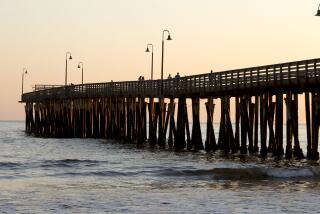At Age 10, Calabasas Feels Growing Pains
A decade after becoming an independent city, Calabasas is finding that being young, single and sought after has definite advantages--and unexpected drawbacks.
This hillside suburb, whose 20,000 residents enjoy a median household income of $83,000, boasts handsome city buildings, a low crime rate, spacious homes, broad greenbelts, a gleaming new shopping center and a strong tax base. But as Calabasas takes solace in those strengths on the 10th anniversary of its incorporation, the city continues to expend energy and money fending off the unwanted advances of developers.
Calabasas officials and residents say a pending explosion in home construction threatens the high-end character of both their town and much of the western Santa Monica Mountains corridor, home to one of Los Angeles County’s richest spreads of unbuilt land. Their most acute anxieties are focused on the Ahmanson Ranch project just over the Ventura County line. The development of 3,050 homes, stores and office buildings would mean a de facto loss of the land-use authority that has been the raison d’etre for Calabasas and its similarly upscale neighbors.
“Clearly land-use planning was what drove cityhood a decade ago,” said Calabasas Mayor Janice Lee, who presides over a slow-growth city council. “And now there’s no question that the biggest threat to us as a city lies with the potential for a new city on top of us.”
Lee and other opponents of the 2,800-acre Ahmanson subdivision, which is financed by Seattle-based Washington Mutual Inc., say its 1992 environmental impact report is outdated and that other studies show the project would swamp the already clogged Ventura Freeway with 200,000 more auto trips a day. That would force large numbers of motorists onto surface streets, said Agoura Hills Mayor Ed Corridori, whose city borders Calabasas.
“If they drop their kids off at school or go to Zuma Beach via Kanan Dume [Road], they’re going to use our surface streets and a freeway interchange,” said Corridori. “And we are in the process of trying to figure out how we are going to pay for them.”
The slow-growth forces also contend that Ahmanson would dirty the water, foul the air and strip the hills of native oaks. Complicating matters is the recent discovery of two rare species on the property--the San Fernando Valley spineflower and the California red-legged frog, which the federal government lists as a threatened amphibian.
Ahmanson spokesman Ian Campbell dismisses the criticism.
“This has been studied exhaustively,” Campbell said. “This is a model project and precisely the kind of development we badly need in Southern California. We’re in the grips in the housing shortage and we have to have a place to house our families.”
William Fulton, president of Solimar Research Group and a senior research fellow at the Southern California Studies Center at USC, says elitism is partly behind the efforts of Calabasas and other west county suburbs such as Westlake Village and Agoura Hills. Slow-growth advocates are worried, he adds, about cheaper housing moving in, even though many of the area’s workers cannot afford to live there.
For example, about half of Calabasas’ residences are in gated communities, and the median home price citywide is $617,000.
“Calabasas will continue to hold the line on growth and they will succeed to a certain extent,” Fulton said. “But as long as they try to attract jobs, they invite pressure to build lower-end housing. And if you prevent the people who work there from living there, well, that’s a difficult public policy equation to maintain.”
Calabasas became Los Angeles County’s 88th and most recent city on April 5, 1991, capping a decade-long movement for independence from the county. The breakaway campaign began after the Board of Supervisors opened the door to intensive development. An early incorporation proposal envisioned a 44-square-mile city of Rancho Las Virgenes, which would have encompassed Calabasas, Agoura Hills and Westlake Village. The Local Agency Formation Commission rejected that idea, and Agoura Hills and Westlake Village residents eventually formed cities of their own, largely to rein in growth.
Calabasas has thrived financially as a municipality. It enjoys budget surpluses each year and has spent generously to expand its stock of parks, ball fields and protected open space. The schools have fared less well, struggling with a 40% jump in enrollment since 1991. Calabasas is part of the Las Virgenes Unified School District, which is adding classrooms to accommodate the surge.
The district offers clean campuses and relatively high test scores. Those are a big draw for young families, and an effective marketing tool for home builders.
“It’s ironic, as we make this a better place to live, more people are going to want to live here,” said Lee, the Calabasas mayor. “When you see other people valuing it, you want it, too.”
More to Read
Sign up for Essential California
The most important California stories and recommendations in your inbox every morning.
You may occasionally receive promotional content from the Los Angeles Times.










